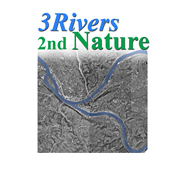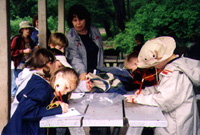Home
Urban Watersheds and Brownfields:
Case Study: Nine Mile Run Watershed
Reiko Goto, Valerie Lucas, Maria Pandazidou
Why an Urban Watershed?
The majority of people live in an urban setting. Traditional city planning minimizes nature and celebrates the structure and infrastructure of culture. There is an emerging consciousness about the relationship between quality of life and the environment. This text will provide students with the method, technique and knowledge to enter into an inquiry on the subjects of urban water and nature. From this inquiry, they will develop critical thinking skills necessary for citizenship and the potential for a life-long interest in natural resources and the issues of urban pollutants. Our goal is to help them understand and develop their own ideas about nature and culture and the range of concepts which inform sustainable development.
- Understanding a watershed entails knowing the topography and geology of the landscape. Topography tells us how water moves across the surface of the earth and the geology can tell us how water moves through soils.
- Understanding your watershed is knowing your place in the cycle of water, and understanding natural systems and constructed cultural systems which move water.
- Understanding your watershed is knowing there are watersheds in every place on the planet and in turn your watershed and daily actions are connected to the planet by the movement of weather and water.
Why an Urban Brownfield?
Go to any city in the modern world, and try to reach the river or the bay. More likely than not you will find your way blocked by fences protecting the ruins of industrial culture. The abandoned properties are considered wasteland, existing in a social and economic limbo, as their value and location is debated. By all accounts, they seem to be stagnant for ten or twenty years or more. How stagnant are they? From the waterside, we will find an emerging growth of amazing plants. Often kingfisher, hawks, and herons have begun to indicate a functioning food chain of smaller herbivores, amphibians, and fish which are returning to the waters once used as the sink for industrial waste. Brownfields are important spaces in cities all over the world: the Ruhr valley of Germany, the coal and steel regions of England, the rustbelt of America. These places are awakening and have increasingly become the site of redevelopment interests. With an awareness of their natural and recreational value, they can also become the site of a new civic discourse about the form and function of the rivers and open spaces in cities. When exploring an urban industrial culture, we have to understand the challenges as well as the opportunities if we are to be participants in the weaving of the post-industrial future.


